Analyzing Adam and Virginia's Coffee Shop: An Economics Case Study
VerifiedAdded on 2019/11/08
|9
|1578
|359
Case Study
AI Summary
This case study examines the economic decisions of Adam and Virginia, who open a coffee shop on Sundays. The analysis delves into profit calculations, differentiating between accounting and economic profits, and considering both fixed and variable costs. It explores the impact of changing penalty rates on costs and profitability, highlighting the concept of sunk costs. The study also addresses the elasticity of demand in a perfectly competitive market and evaluates the rationale for expansion based on the MR-MC rule. The entrepreneurs are rational in their decision to open a coffee shop, as they achieve positive economic profits even after accounting for opportunity costs, and the case study concludes that they should expand their business when variable costs decrease.
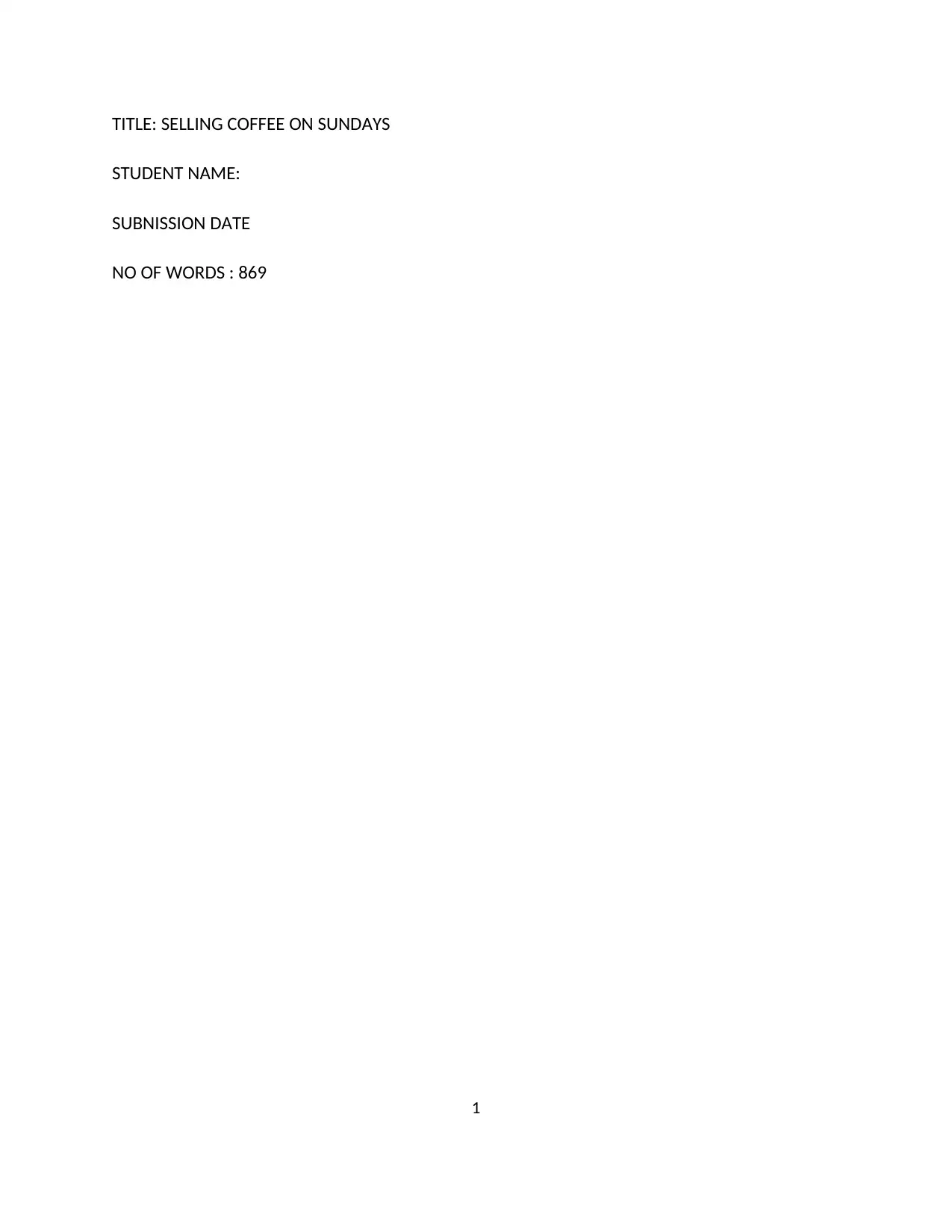
TITLE: SELLING COFFEE ON SUNDAYS
STUDENT NAME:
SUBNISSION DATE
NO OF WORDS : 869
1
STUDENT NAME:
SUBNISSION DATE
NO OF WORDS : 869
1
Paraphrase This Document
Need a fresh take? Get an instant paraphrase of this document with our AI Paraphraser
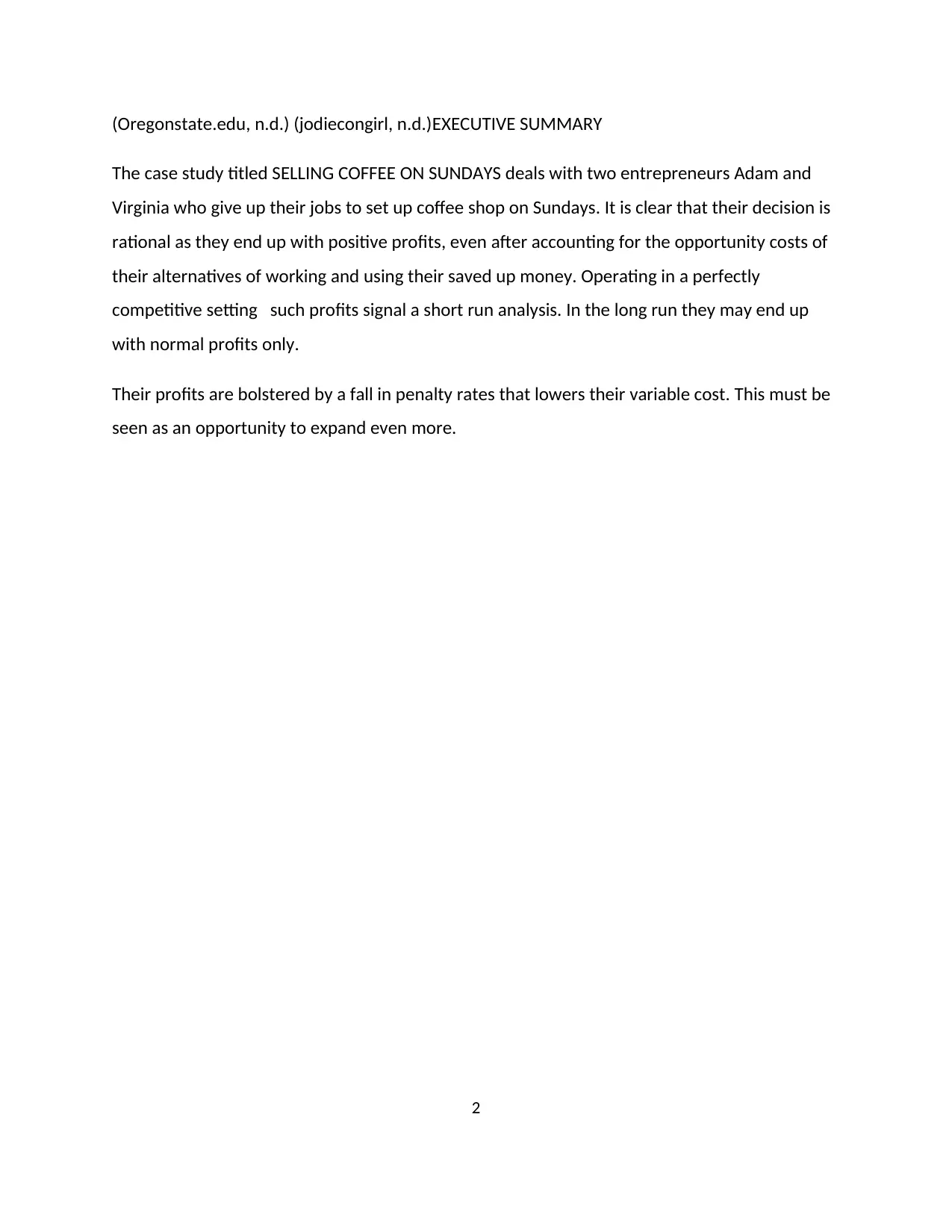
(Oregonstate.edu, n.d.) (jodiecongirl, n.d.)EXECUTIVE SUMMARY
The case study titled SELLING COFFEE ON SUNDAYS deals with two entrepreneurs Adam and
Virginia who give up their jobs to set up coffee shop on Sundays. It is clear that their decision is
rational as they end up with positive profits, even after accounting for the opportunity costs of
their alternatives of working and using their saved up money. Operating in a perfectly
competitive setting such profits signal a short run analysis. In the long run they may end up
with normal profits only.
Their profits are bolstered by a fall in penalty rates that lowers their variable cost. This must be
seen as an opportunity to expand even more.
2
The case study titled SELLING COFFEE ON SUNDAYS deals with two entrepreneurs Adam and
Virginia who give up their jobs to set up coffee shop on Sundays. It is clear that their decision is
rational as they end up with positive profits, even after accounting for the opportunity costs of
their alternatives of working and using their saved up money. Operating in a perfectly
competitive setting such profits signal a short run analysis. In the long run they may end up
with normal profits only.
Their profits are bolstered by a fall in penalty rates that lowers their variable cost. This must be
seen as an opportunity to expand even more.
2

TABLE OF CONTENTS
INTRODUCTION 4
ANALYTICAL DEVELOPMENT 5
CONCLUSION 7
APPENDIX 8
3
INTRODUCTION 4
ANALYTICAL DEVELOPMENT 5
CONCLUSION 7
APPENDIX 8
3
⊘ This is a preview!⊘
Do you want full access?
Subscribe today to unlock all pages.

Trusted by 1+ million students worldwide
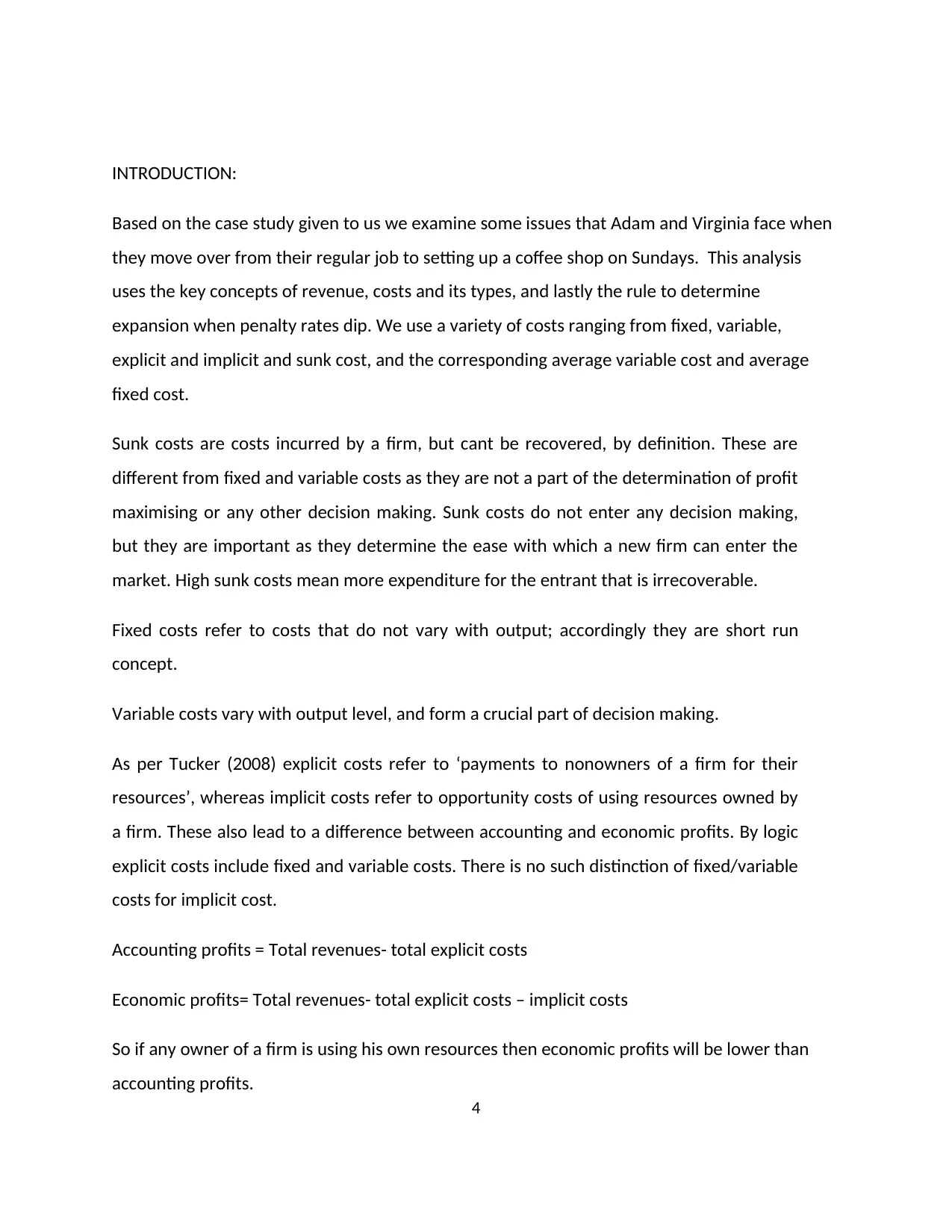
INTRODUCTION:
Based on the case study given to us we examine some issues that Adam and Virginia face when
they move over from their regular job to setting up a coffee shop on Sundays. This analysis
uses the key concepts of revenue, costs and its types, and lastly the rule to determine
expansion when penalty rates dip. We use a variety of costs ranging from fixed, variable,
explicit and implicit and sunk cost, and the corresponding average variable cost and average
fixed cost.
Sunk costs are costs incurred by a firm, but cant be recovered, by definition. These are
different from fixed and variable costs as they are not a part of the determination of profit
maximising or any other decision making. Sunk costs do not enter any decision making,
but they are important as they determine the ease with which a new firm can enter the
market. High sunk costs mean more expenditure for the entrant that is irrecoverable.
Fixed costs refer to costs that do not vary with output; accordingly they are short run
concept.
Variable costs vary with output level, and form a crucial part of decision making.
As per Tucker (2008) explicit costs refer to ‘payments to nonowners of a firm for their
resources’, whereas implicit costs refer to opportunity costs of using resources owned by
a firm. These also lead to a difference between accounting and economic profits. By logic
explicit costs include fixed and variable costs. There is no such distinction of fixed/variable
costs for implicit cost.
Accounting profits = Total revenues- total explicit costs
Economic profits= Total revenues- total explicit costs – implicit costs
So if any owner of a firm is using his own resources then economic profits will be lower than
accounting profits.
4
Based on the case study given to us we examine some issues that Adam and Virginia face when
they move over from their regular job to setting up a coffee shop on Sundays. This analysis
uses the key concepts of revenue, costs and its types, and lastly the rule to determine
expansion when penalty rates dip. We use a variety of costs ranging from fixed, variable,
explicit and implicit and sunk cost, and the corresponding average variable cost and average
fixed cost.
Sunk costs are costs incurred by a firm, but cant be recovered, by definition. These are
different from fixed and variable costs as they are not a part of the determination of profit
maximising or any other decision making. Sunk costs do not enter any decision making,
but they are important as they determine the ease with which a new firm can enter the
market. High sunk costs mean more expenditure for the entrant that is irrecoverable.
Fixed costs refer to costs that do not vary with output; accordingly they are short run
concept.
Variable costs vary with output level, and form a crucial part of decision making.
As per Tucker (2008) explicit costs refer to ‘payments to nonowners of a firm for their
resources’, whereas implicit costs refer to opportunity costs of using resources owned by
a firm. These also lead to a difference between accounting and economic profits. By logic
explicit costs include fixed and variable costs. There is no such distinction of fixed/variable
costs for implicit cost.
Accounting profits = Total revenues- total explicit costs
Economic profits= Total revenues- total explicit costs – implicit costs
So if any owner of a firm is using his own resources then economic profits will be lower than
accounting profits.
4
Paraphrase This Document
Need a fresh take? Get an instant paraphrase of this document with our AI Paraphraser

ANALYTICAL DEVELOPMENT
We look at arrange of issues here separately.
i. PROFITS
We start with accounting and economic profits first. We segregate all costs under various
headings:
Fixed costs include the rent paid for coffee machine and sundries (coffee and cups) =
1000+500=1500
Variable costs = wages = 5 workers *10 hours @40 per hour = 2000
Total revenues = 3*4000 cups = 12000
So accounting profits = 12000-2000-15000= 8500
Now we account for implicit costs, which include
1. wages of Adam and Virginia = 400*2 =800
2. Rent they could have received for the shop premises if they chose not to operate themselves =
1500
3. Own money they use after withdrawing from bank = 2*200 = 400
Total implicit costs = 800+400+1500 = 2700
So Economic profits = 8500-2700 = 5800
The average cost under this scenario of a penalty @40 per hour will be total explicit cost /
4000= 3500/4000 = $0.875. This average cost concept only includes accounting profits that use
explicit costs.
5
We look at arrange of issues here separately.
i. PROFITS
We start with accounting and economic profits first. We segregate all costs under various
headings:
Fixed costs include the rent paid for coffee machine and sundries (coffee and cups) =
1000+500=1500
Variable costs = wages = 5 workers *10 hours @40 per hour = 2000
Total revenues = 3*4000 cups = 12000
So accounting profits = 12000-2000-15000= 8500
Now we account for implicit costs, which include
1. wages of Adam and Virginia = 400*2 =800
2. Rent they could have received for the shop premises if they chose not to operate themselves =
1500
3. Own money they use after withdrawing from bank = 2*200 = 400
Total implicit costs = 800+400+1500 = 2700
So Economic profits = 8500-2700 = 5800
The average cost under this scenario of a penalty @40 per hour will be total explicit cost /
4000= 3500/4000 = $0.875. This average cost concept only includes accounting profits that use
explicit costs.
5
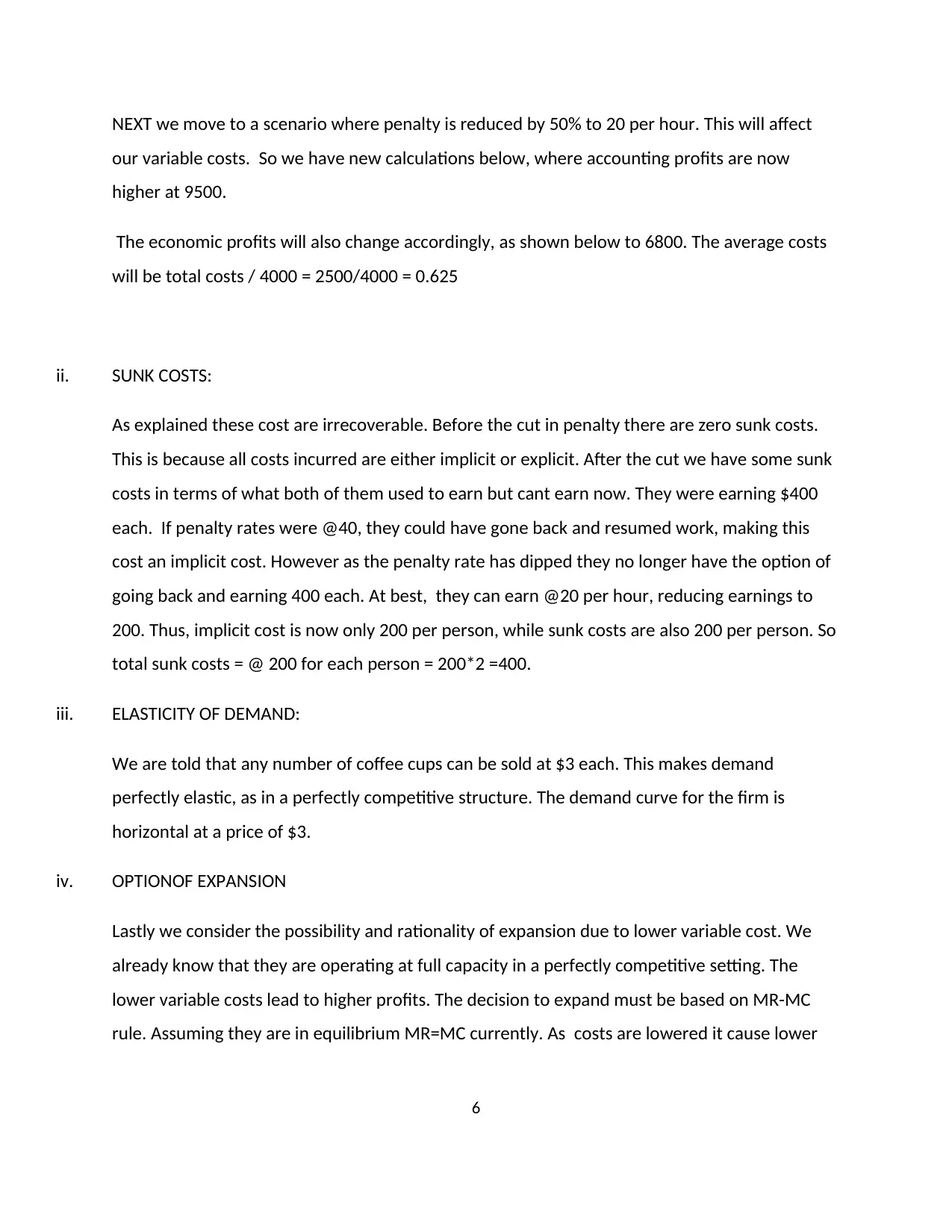
NEXT we move to a scenario where penalty is reduced by 50% to 20 per hour. This will affect
our variable costs. So we have new calculations below, where accounting profits are now
higher at 9500.
The economic profits will also change accordingly, as shown below to 6800. The average costs
will be total costs / 4000 = 2500/4000 = 0.625
ii. SUNK COSTS:
As explained these cost are irrecoverable. Before the cut in penalty there are zero sunk costs.
This is because all costs incurred are either implicit or explicit. After the cut we have some sunk
costs in terms of what both of them used to earn but cant earn now. They were earning $400
each. If penalty rates were @40, they could have gone back and resumed work, making this
cost an implicit cost. However as the penalty rate has dipped they no longer have the option of
going back and earning 400 each. At best, they can earn @20 per hour, reducing earnings to
200. Thus, implicit cost is now only 200 per person, while sunk costs are also 200 per person. So
total sunk costs = @ 200 for each person = 200*2 =400.
iii. ELASTICITY OF DEMAND:
We are told that any number of coffee cups can be sold at $3 each. This makes demand
perfectly elastic, as in a perfectly competitive structure. The demand curve for the firm is
horizontal at a price of $3.
iv. OPTIONOF EXPANSION
Lastly we consider the possibility and rationality of expansion due to lower variable cost. We
already know that they are operating at full capacity in a perfectly competitive setting. The
lower variable costs lead to higher profits. The decision to expand must be based on MR-MC
rule. Assuming they are in equilibrium MR=MC currently. As costs are lowered it cause lower
6
our variable costs. So we have new calculations below, where accounting profits are now
higher at 9500.
The economic profits will also change accordingly, as shown below to 6800. The average costs
will be total costs / 4000 = 2500/4000 = 0.625
ii. SUNK COSTS:
As explained these cost are irrecoverable. Before the cut in penalty there are zero sunk costs.
This is because all costs incurred are either implicit or explicit. After the cut we have some sunk
costs in terms of what both of them used to earn but cant earn now. They were earning $400
each. If penalty rates were @40, they could have gone back and resumed work, making this
cost an implicit cost. However as the penalty rate has dipped they no longer have the option of
going back and earning 400 each. At best, they can earn @20 per hour, reducing earnings to
200. Thus, implicit cost is now only 200 per person, while sunk costs are also 200 per person. So
total sunk costs = @ 200 for each person = 200*2 =400.
iii. ELASTICITY OF DEMAND:
We are told that any number of coffee cups can be sold at $3 each. This makes demand
perfectly elastic, as in a perfectly competitive structure. The demand curve for the firm is
horizontal at a price of $3.
iv. OPTIONOF EXPANSION
Lastly we consider the possibility and rationality of expansion due to lower variable cost. We
already know that they are operating at full capacity in a perfectly competitive setting. The
lower variable costs lead to higher profits. The decision to expand must be based on MR-MC
rule. Assuming they are in equilibrium MR=MC currently. As costs are lowered it cause lower
6
⊘ This is a preview!⊘
Do you want full access?
Subscribe today to unlock all pages.

Trusted by 1+ million students worldwide
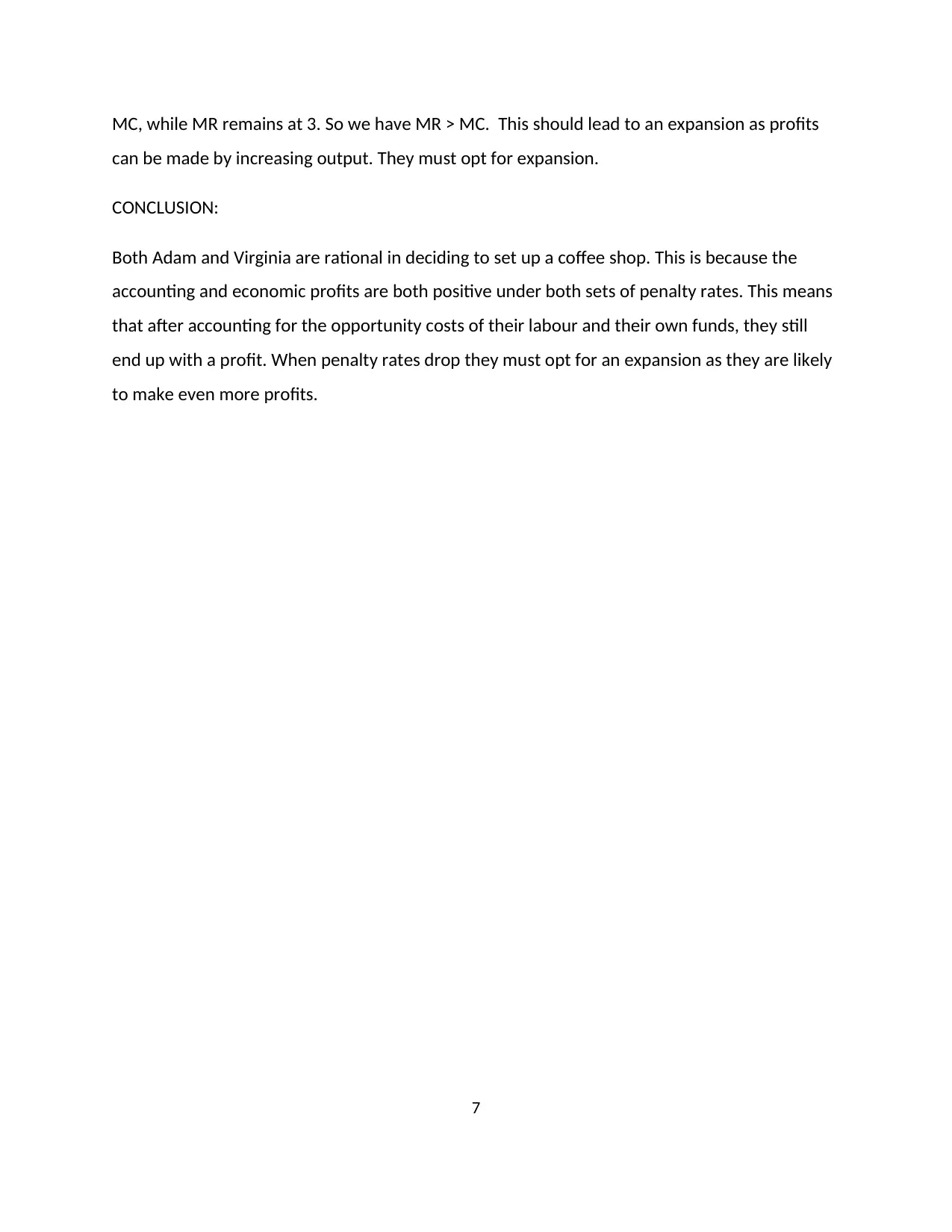
MC, while MR remains at 3. So we have MR > MC. This should lead to an expansion as profits
can be made by increasing output. They must opt for expansion.
CONCLUSION:
Both Adam and Virginia are rational in deciding to set up a coffee shop. This is because the
accounting and economic profits are both positive under both sets of penalty rates. This means
that after accounting for the opportunity costs of their labour and their own funds, they still
end up with a profit. When penalty rates drop they must opt for an expansion as they are likely
to make even more profits.
7
can be made by increasing output. They must opt for expansion.
CONCLUSION:
Both Adam and Virginia are rational in deciding to set up a coffee shop. This is because the
accounting and economic profits are both positive under both sets of penalty rates. This means
that after accounting for the opportunity costs of their labour and their own funds, they still
end up with a profit. When penalty rates drop they must opt for an expansion as they are likely
to make even more profits.
7
Paraphrase This Document
Need a fresh take? Get an instant paraphrase of this document with our AI Paraphraser

APPENDIX
BEFORE PENALTY CUT: ACCOUNTING PROFIT
FIXED COST VARIABLE COST TOTAL COSTS REVENUES PROFITS
RENT FOR
MACHINE SUNDRIES WAGES FIXED+VARIABLE COST
1000 500 5 WORKERS *40*10 = 2000 .=1000+500+2000= 3500 .=4000*3=12000 . = 12000-3500 = 8500
BEFORE PENALTY CUT: ECONOMIC PROFIT
FIXED COST VARIABLE COST TOTAL COSTS REVENUES PROFITS
RENT FOR
MACHINE SUNDRIES WAGES FIXED+VARIABLE COST
1000 500 5 WORKERS *40*10 = 2000
.=2700+1000+500+2000=
6200 .=4000*3=12000
. = 12000-6200
= 5800
IMPLICIT COSTS
OWN WAGES MONEY WITHDRAWN RENT TOTAL
.= 2*400 =800 . = 2*200 =400 1500 2700
AFTER PENALTY CUT: ACCOUNTING PROFIT
FIXED COST VARIABLE COST TOTAL COSTS REVENUES PROFITS
RENT FOR
MACHINE SUNDRIES WAGES FIXED+VARIABLE COST
1000 500 5 WORKERS *20*10 =1000 .=1000+500+1000= 2500 .=4000*3=12000 . = 12000-2500 = 9500
AFTER PENALTY CUT: ECONOMIC PROFIT
FIXED COST VARIABLE COST TOTAL COSTS REVENUES PROFITS
RENT FOR
MACHINE SUNDRIES WAGES FIXED+VARIABLE COST
1000 500 5 WORKERS *20*10 =1000
.=2300+1000+500+10
00= 4800 .=4000*3=12000
. = 12000-
4800 = 7200
IMPLICIT COSTS
OWN WAGES MONEY WITHDRAWN RENT TOTAL
.= 2*200 =400 . = 2*200 =400 1500 2300
8
BEFORE PENALTY CUT: ACCOUNTING PROFIT
FIXED COST VARIABLE COST TOTAL COSTS REVENUES PROFITS
RENT FOR
MACHINE SUNDRIES WAGES FIXED+VARIABLE COST
1000 500 5 WORKERS *40*10 = 2000 .=1000+500+2000= 3500 .=4000*3=12000 . = 12000-3500 = 8500
BEFORE PENALTY CUT: ECONOMIC PROFIT
FIXED COST VARIABLE COST TOTAL COSTS REVENUES PROFITS
RENT FOR
MACHINE SUNDRIES WAGES FIXED+VARIABLE COST
1000 500 5 WORKERS *40*10 = 2000
.=2700+1000+500+2000=
6200 .=4000*3=12000
. = 12000-6200
= 5800
IMPLICIT COSTS
OWN WAGES MONEY WITHDRAWN RENT TOTAL
.= 2*400 =800 . = 2*200 =400 1500 2700
AFTER PENALTY CUT: ACCOUNTING PROFIT
FIXED COST VARIABLE COST TOTAL COSTS REVENUES PROFITS
RENT FOR
MACHINE SUNDRIES WAGES FIXED+VARIABLE COST
1000 500 5 WORKERS *20*10 =1000 .=1000+500+1000= 2500 .=4000*3=12000 . = 12000-2500 = 9500
AFTER PENALTY CUT: ECONOMIC PROFIT
FIXED COST VARIABLE COST TOTAL COSTS REVENUES PROFITS
RENT FOR
MACHINE SUNDRIES WAGES FIXED+VARIABLE COST
1000 500 5 WORKERS *20*10 =1000
.=2300+1000+500+10
00= 4800 .=4000*3=12000
. = 12000-
4800 = 7200
IMPLICIT COSTS
OWN WAGES MONEY WITHDRAWN RENT TOTAL
.= 2*200 =400 . = 2*200 =400 1500 2300
8
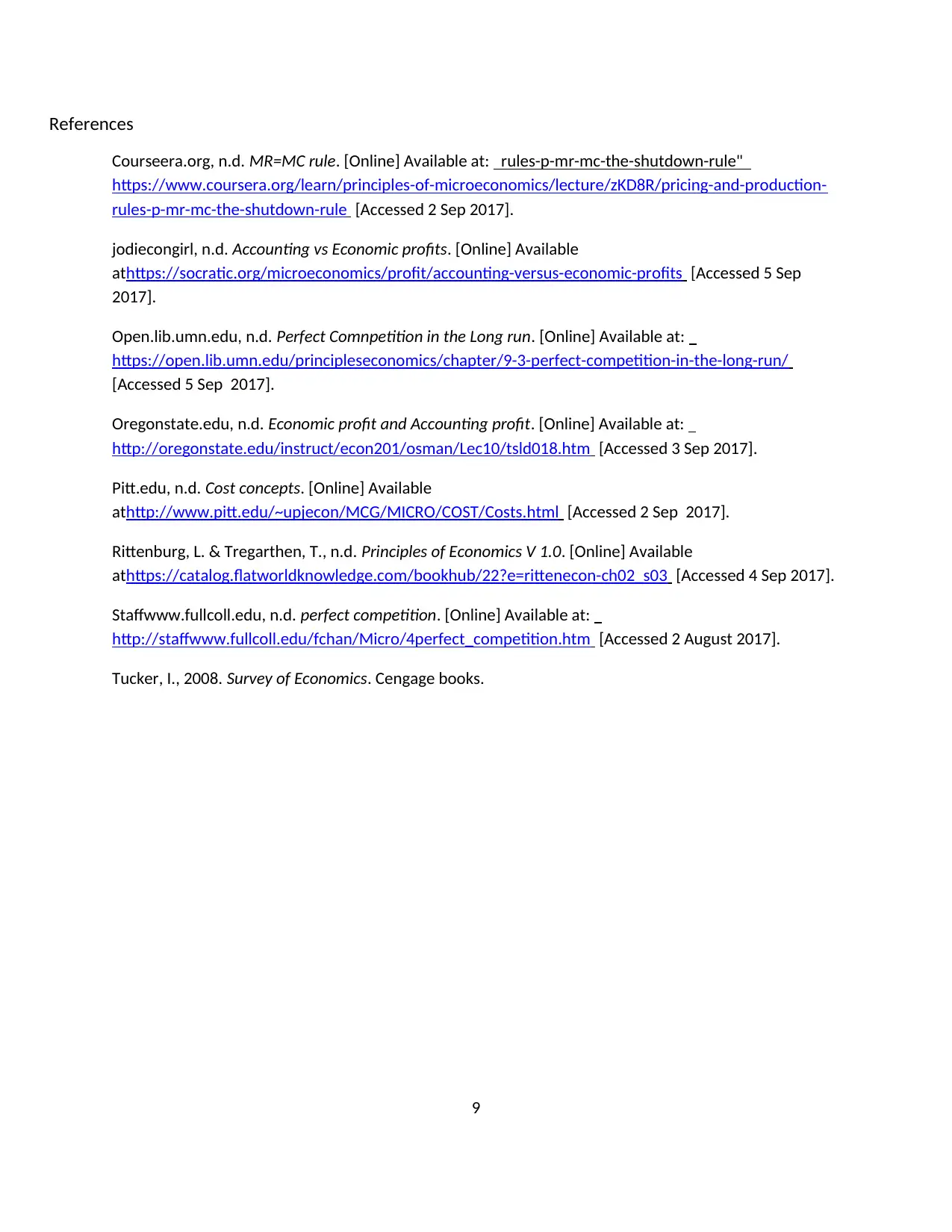
References
Courseera.org, n.d. MR=MC rule. [Online] Available at: rules-p-mr-mc-the-shutdown-rule"
https://www.coursera.org/learn/principles-of-microeconomics/lecture/zKD8R/pricing-and-production-
rules-p-mr-mc-the-shutdown-rule [Accessed 2 Sep 2017].
jodiecongirl, n.d. Accounting vs Economic profits. [Online] Available
athttps://socratic.org/microeconomics/profit/accounting-versus-economic-profits [Accessed 5 Sep
2017].
Open.lib.umn.edu, n.d. Perfect Comnpetition in the Long run. [Online] Available at:
https://open.lib.umn.edu/principleseconomics/chapter/9-3-perfect-competition-in-the-long-run/
[Accessed 5 Sep 2017].
Oregonstate.edu, n.d. Economic profit and Accounting profit. [Online] Available at:
http://oregonstate.edu/instruct/econ201/osman/Lec10/tsld018.htm [Accessed 3 Sep 2017].
Pitt.edu, n.d. Cost concepts. [Online] Available
athttp://www.pitt.edu/~upjecon/MCG/MICRO/COST/Costs.html [Accessed 2 Sep 2017].
Rittenburg, L. & Tregarthen, T., n.d. Principles of Economics V 1.0. [Online] Available
athttps://catalog.flatworldknowledge.com/bookhub/22?e=rittenecon-ch02_s03 [Accessed 4 Sep 2017].
Staffwww.fullcoll.edu, n.d. perfect competition. [Online] Available at:
http://staffwww.fullcoll.edu/fchan/Micro/4perfect_competition.htm [Accessed 2 August 2017].
Tucker, I., 2008. Survey of Economics. Cengage books.
9
Courseera.org, n.d. MR=MC rule. [Online] Available at: rules-p-mr-mc-the-shutdown-rule"
https://www.coursera.org/learn/principles-of-microeconomics/lecture/zKD8R/pricing-and-production-
rules-p-mr-mc-the-shutdown-rule [Accessed 2 Sep 2017].
jodiecongirl, n.d. Accounting vs Economic profits. [Online] Available
athttps://socratic.org/microeconomics/profit/accounting-versus-economic-profits [Accessed 5 Sep
2017].
Open.lib.umn.edu, n.d. Perfect Comnpetition in the Long run. [Online] Available at:
https://open.lib.umn.edu/principleseconomics/chapter/9-3-perfect-competition-in-the-long-run/
[Accessed 5 Sep 2017].
Oregonstate.edu, n.d. Economic profit and Accounting profit. [Online] Available at:
http://oregonstate.edu/instruct/econ201/osman/Lec10/tsld018.htm [Accessed 3 Sep 2017].
Pitt.edu, n.d. Cost concepts. [Online] Available
athttp://www.pitt.edu/~upjecon/MCG/MICRO/COST/Costs.html [Accessed 2 Sep 2017].
Rittenburg, L. & Tregarthen, T., n.d. Principles of Economics V 1.0. [Online] Available
athttps://catalog.flatworldknowledge.com/bookhub/22?e=rittenecon-ch02_s03 [Accessed 4 Sep 2017].
Staffwww.fullcoll.edu, n.d. perfect competition. [Online] Available at:
http://staffwww.fullcoll.edu/fchan/Micro/4perfect_competition.htm [Accessed 2 August 2017].
Tucker, I., 2008. Survey of Economics. Cengage books.
9
⊘ This is a preview!⊘
Do you want full access?
Subscribe today to unlock all pages.

Trusted by 1+ million students worldwide
1 out of 9
Related Documents
Your All-in-One AI-Powered Toolkit for Academic Success.
+13062052269
info@desklib.com
Available 24*7 on WhatsApp / Email
![[object Object]](/_next/static/media/star-bottom.7253800d.svg)
Unlock your academic potential
Copyright © 2020–2025 A2Z Services. All Rights Reserved. Developed and managed by ZUCOL.





